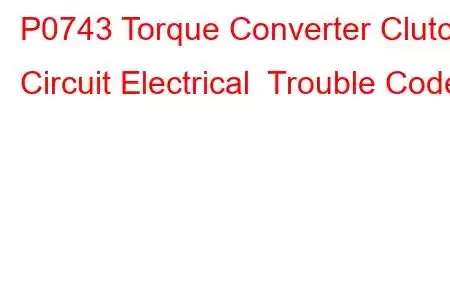P0743 Torque Converter Clutch (TCC) Solenoid Circuit Electrical
OBD-II Trouble Code Technical Description
Torque Converter Clutch (TCC) Solenoid Circuit Electrical
This diagnostic trouble code (DTC) is a generic powertrain code, which means that it applies to OBD-II equipped vehicles. Although generic, the specific repair steps may vary depending on make/model.
What does that mean?
This diagnostic trouble code is set when the Engine Management Computer (EMC) also known as the Powertrain Control Module (PCM) and also known as the Engine Control Module (ECM) detects a fault with the torque converter clutch (TCC) solenoid electrical circuit, which is contained inside the transmission.
An automatic transmission is not 100% efficient because it is a fluid coupling that connects the engine to the rest of the internal transmission parts. The torque convertor transfers power using hydraulic force and it is internal to the transmission assembly. With that transfer of power comes excessive heat. The lockup torque converter was designed to make the transmission more efficient at highway speeds and to control heat. The torque convertor clutch is what lockups the convertor. Heat kills transmissions. That is why you hear that stop and go traffic is hard on a automatic transmission
The converter clucth does not lockup at these low speeds therefore heat is generated. This clutch is controlled by an electrical solenoid. The torque convertor clutch is locked changing the fluid coupling to a mechanical one. This solenoid uses power and ground sent through a coil of wires which creates a magnetic field to pull or push a central metal rod. When the solenoid is energized or de-energized, it directs fluid flow through the valve body of the transmission.
Symptoms
Symptoms of a P0743 DTC may include:
Malfunction indicator illumination (check engine light or service engine soon light) Stalling when coming to a stop after cruising speeds Shudder on take off Shudder when coming to a stopCauses
Potential causes may include:
Low or dirty transmission fluid Wire/circuit issue shorted to power or ground Failed torque converter clutch (TCC) solenoid Failed TCC assembly in the torque converter Failed PCM/ECM/EMCNote: This may well be an intermittent condition and may not show up again, so clear the code and keep monitoring.
Possible Solutions
First you need to gather some tools together or borrow some (a rare occurrence with mechanics as our tools are our livelihood and we don't like to lend out our tools):
On Board Diagnostic (OBD-II) scan tool - to pull the code; can be found at many parts stores, online, or many parts stores will pull the code for free Multimeter that has a resistance (or OHM) reading Self powered test light/probe (a Power Probe III works wonders here). If you don’t have a Power Probe, a simple set of fused jumper wires and a test light will suffice Wire diagrams will be very helpful - you can get these in a Haynes manual or if your friendly with the dealer or your local mechanic, they may be able to run off a photocopyTIP: Remember in most cases there’s an internal transmission harness that connects the TCC solenoid and shift solenoids, so the wire fault may only happen when the transmission is hot or cold. Or, when the vehicle is driven above bumps or when making a turn. Make every attempt to recreate it!
TIP: Before addressing any transmission issue make sure the engine is running in tip top shape! Address any other sensor codes or lean/rich codes first. There are a lot of sensors that are networked together that determine transmission shift scheduling. If one is "offline/faulty" then the ECM/PCM/EMC may be throwing this code through the fault it sees at another sensor.
TIP: Many times a simple fluid and filter change will take care of minor transmission i
Read: 32


